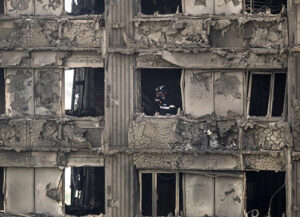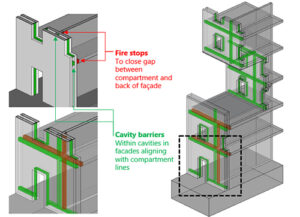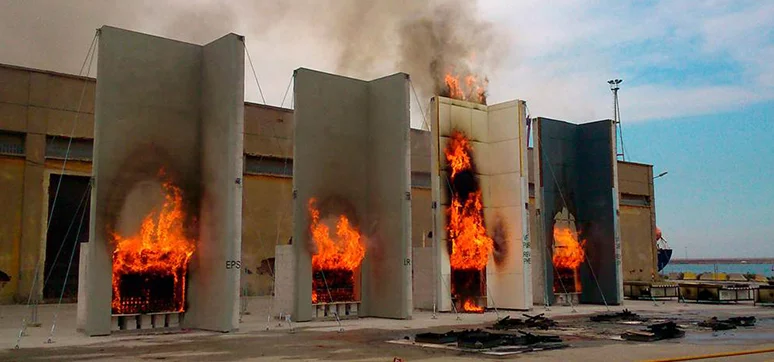What are the impacts of façade design on the fire safety of buildings?
There are quite a few impacts, such as falling debris and fire spread between buildings. However, the most significant impact on building fire safety in the façade design is the potential to breach compartmentation within the building. All buildings are divided into defined compartments. These compartments are separated by construction that can achieve a level of fire resistance/fire stopping. The purpose of doing so is to restrict the spread of fire and contain heat & smoke to the area where the fire originated.
Curtain wall systems, or other types of insulated façade designs, have the potential to offer a path for fire spread between compartments. If this occurs the façade design can breach the fire-resistant separation resulting in a much larger fire than assumed within the design of a building’s fire strategy. The consequences are that people could become trapped, attending fire crews could be prevented from accessing the fire, and, the building could collapse whilst either of these two eventualities is in process.
The most infamous case study would be the Grenfell Tower disaster: the insulation installed over the existing building was a pathway for fire to spread floor to floor. This residential building had been designed to compartmentalize each floor – meaning the fire strategy, the design has assumed a fire could be contained in the floor of fire origin (actually, the apartment of fire origin). As such, the means of escape design had assumed a ‘defend in place’ strategy – as the fire-resistant floor and walls were designed to limit the spread of heat & smoke. When the compartmentation was compromised, as the fire spread floor to floor via the façade, the alarm strategy, stair smoke clearance, and exit capacity were all in turn compromised.
What is the role of the fenestration design in fire-safe buildings?

The orientation of openings within a façade offers a potential path for the fire spread, as described above. Where a window, louver, grill, door, etc. is not adequately fire-stopped, a fire can spread via the fenestration into the façade system. A large number of existing façade systems installed in the last 20 years contain combustible insulation or panels due to the thermal benefits to the performance of the building. Ignition of this material can cause fire spread, as well as add to the fire load contained in the external walls of the building.
Fire stopping is an essential element within the passive fire protection of the building. The intent of such protection in the design of a façade system is to continue the compartmentation (the walls or floors) out to the building exterior. Spandrel panels are a good example, as are cavity barriers. Often these are not considered during the design, or, are inadequately installed during construction.
Likewise, the testing of façade systems often negates the inclusion of fenestration. The NFPA 285 test only considers an exemplar window opening. So, when a façade system is tested the results do not account for the risk of spread into the cavity via various window orientations, doors, louver, etc. Where this occurs in the Middle East, it is common practice to adopt an engineering judgment – an approval pathway that is being questioned around the world due to the unquantifiable fire risk.
Can you identify some of the potential remediation methods that can be adopted within façade design that could lower the fire risk?
There are a number of measures that can be adopted within existing façade systems to improve fire safety. All assessments undertaken by professionals should be consulted with the wider stakeholder party to ensure all considerations are accounted for. Here is an example – we were appointed to assess an existing building before a client made a purchase. Panel cores and insulation samples were taken for testing in the lab. These identified that the material installed was combustible, and, the desktop review and inspection demonstrated that inadequate fire-stopping and cavity barriers were installed to match the floor-by-floor compartmentation strategy. Whether the design was inadequate, or the installation was at fault, was not clear as the building was more than 10 years old and hence lacked installation reports, documentation, or construction photos.
With this information, we undertook a full building-wide holistic fire risk assessment of the means of egress, active fire systems, passive protection, and, the Civil Defence access facilities. We were able to show that a firestop every second floor (assuming a fire across two floors as a worst-case) would be sufficient to enable people to escape and attend fire crews to tackle a fire. However, when we consulted with the insurer, they advised they had only ever considered a fire on one floor as the worst case. Meaning, that whilst life safety and firefighter safety could be accounted for, the property protection measures needed to be more stringent, and required fire stopping at every floor.
A remediation study should be undertaken by competent professionals in collaboration with the entire stakeholder body. Where deficiencies in knowledge are identified these should be engaged before a decision on the best course of action is agreed upon. Typically, the choice of remediation measures can be categorized into short, medium, or long-term;
• Short-term covers the introduction of temporary detection ahead of system overhaul, full building inspections, management of evacuation strategies, and, the removal of transient fuel load and ignition sources.
• Medium-term can include testing and maintenance of existing systems (sprinklers, smoke control, door openers), increasing fire detection coverage, and improved occupant training.
• Long-term typically involves a planning application, relocating occupants, and significant rectification works such as fire stopping, enhanced sprinkler coverage, capping balcony, gas mains, and ultimately a full or partial replacement of the system with a tested, compliant façade (that poses a lower fire risk).
What scenarios could cause an internal building fire to spread to the external façade and other parts of the building? What protection measures are in place to control fire?

The most common measure to prevent the spread of fire in a building is sprinkler protection. In the 2014 LaCrosse fire in Melbourne, the fire spread from level 6 to level 21 via the façade. Whilst the façade system failed to prevent fire spread, the sprinkler system worked beyond expectation – up to 24 heads operated in system design for only 4 heads to activate at one time. As such, the fire did not spread into the building, and all of the 100 evacuees survived.
Around much of the world, legislation has now changed in the aftermath of the Grenfell disaster, to mandate that sprinklers be installed in newly built high-rise residential buildings over a given height (typically where external access is not possible by attending fire crews). Whilst sprinklers in high-rise buildings are a common design aspect the risk of people being trapped is addressed by further lowering the height at which this is mandated. It can be challenging to retrospectively install sprinklers in an existing building due to the infrastructure demand, sprinklers can be fed from the mains or potable water in some jurisdictions meaning this can be a potential rectification measure to lower the fire risk.
What are the various aspects of façades which could prevent the spread of fire in the building?
Fundamental to the design of a façade system is the continuation of the building compartmentation. Where a compartment wall/floor meets the façade system a fire stop should be included to ensure there is not a path of the unseen fire to spread into an adjoining compartment. This can be particularly challenging where the façade design does not align with the compartmentation – in such instances a bespoke fire stopping, or fire barrier, solution can be considered. However, it is recommended these undergo project-specific testing.
Where ventilated cavities exist in a building as part of the wider façade design strategy, a cavity is inherently created that links multiple floors together, circumnavigating compartmentation. This has become an ever more common arrangement, and the need to close the cavity in the event of a fire is of concern. To address this aspect of design, cavity barriers are provided with an intumescent seal. The intumescent seal is a strip that expands when subject to heat, and closes off the cavity, helping to restrict smoke and fire spread through the cavity when fully closed, but allowing ventilation day-to-day.
Could you please tell us about the difference between fire stops and smoke stops?
There are three mechanisms that a fire-resistant system can achieve: integrity (resistance to the passage of smoke), insulation (resistance to the passage of heat), and stability (resistance to structural failure). Depending on the purpose of the compartment design, the wall/floor may only need to resist the passage of smoke. When this is the case a smoke stop is required. Where a wall/floor is required to resist the passage of heat & smoke a fire stop is required. Always consult your Fire Engineer when specifying the necessary passive protection measures!
How important is the use of fire-rated glass?

Glazing that has been designed to resist the passage of fire (insulation & integrity) is typically used where a window is required in a fire-resistance-rated partition wall or floor. Such an approach can offer the benefits of natural light but comes with challenges in terms of costs and the limitations of height & width. Other options are sprinkler-protected toughened glazing, or, ensuring that the compartmentation strategy within a building is designed such that open connection between areas can be achieved without the need for fire-resistant separation.
A good Fire Engineer should be able to deliver on this. Where fire-rated glazing is required it can offer either resistance to the passage of smoke, or, smoke & heat. The former is often achieved by toughened glazing where a suitable analysis is undertaken. All good manufacturers and suppliers will be able to advise on when and where such products need to be specified – as well as the fire engineer.
Of course, fire-resistant construction could be required in a façade where the building is close to an adjoining building or the build plotline. Again, this can include fire-rated glazing, however, there are real benefits in engaging a Fire Engineer to assess the necessary protection measures to enable design flexibility and minimise production costs.
What are passive and active fire safety protection methods?
Passive systems are those typically applied to the primary structure (the elements holding up the building) and the secondary structures (all other elements, including the façade). Compartment walls and floors are considered primary elements, whilst the fenestration, for example, would be considered secondary. Discussed above are the benefits and role of compartmentation, including fire-stopping and cavity barriers. Active systems, on the other hand, include sprinklers, smoke control, hydrants, hose reels, etc. Hence active systems can be used in the protection of glazing (window wetting sprinklers), but predominately passive systems are utilised in façade and fenestration protection.
What can be done to prevent fire spread in buildings? Please suggest some steps.
Fire spread via the façade occurs for a number of reasons. If we consider case studies, numerous scenarios have occurred during construction. The challenge is: that whilst the finished installation may be adequately protected, exposed insulation or unsealed panel systems can offer a route for ignition to occur. This was the cause of the 2015 fire in Binagadi, Baku, and, the 2010 fire in Jing’an District, Shanghai. A competent contractor who understands the need for dynamic risk assessment permits to work, and, hot work permits will be able to advise on how this can be mitigated.
Likewise, façade fires in occupied buildings have occurred where either the design has not provided the necessary fire protection (fire stops, cavity barriers, combustible insulation), the contractor has installed hazardous systems (100% PE cores, combustible insulation, timber framing, polystyrene panels), or, the operation of the building contradicts the assumptions made in the design (fire pits or barbeques on balconies, cars parked against façade panels). The disconnection between the design and the construction is well known within building engineering, and within fire engineering, this is further exacerbated by the disconnection between the design and the operation. Measures are being taken to resolve this around the globe – success is typically driven by legislation as the capital gained from paying for safety is hard to quantify when a construction budget is being drafted.














